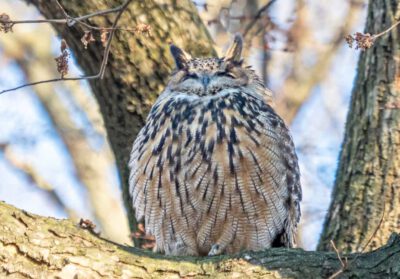
Flaco, an Eurasian Eagle-Owl, first gained fame when he escaped the Central Park Zoo after an act of vandalism of his enclosure over a year ago. His presence in Central Park drew bird lovers from New York City and beyond eager to catch a glimpse of an enigmatic — and very large — owl. Flaco captured the imaginations of people around the world and brought birds close to home for New Yorkers. Now, millions who were captivated by Flaco are mourning his loss after he died over the weekend, the result of a collision with a building.
Flaco's fate is shared by up to one billion birds each year in the United States, making collisions with buildings one of the leading causes of bird mortality. Flaco's death has spurred action in the New York State Senate, which announced it would rename its Bird Safe Buildings Act the FLACO (“Feathered Lives Also Count”) Act. If passed, the FLACO Act would require new and significantly altered state buildings to adopt bird-friendly designs, especially on windows. This measure would save countless birds' lives.
Solving a problem of this magnitude requires big thinking, bold ideas, and policy change, but you don't need to wait for legislation in your state to take action to prevent unnecessary bird deaths. As spring migration approaches, billions of birds will be on the move at night as they migrate to their breeding grounds. Simple actions can make this journey safer.
During migration, billions of birds navigate difficult human-made environments as they fly to their breeding grounds in the spring. Sadly, many will not reach their destinations. The problem grows in the fall as birds make the return trip south, this time with inexperienced juveniles joining the journey. These birds may not come from as far away as an Eurasian Eagle-Owl, but they are making flights of many thousands of miles, coming from as far away as Brazil.
Why Do Birds Hit Windows?
Most birds, such as the Indigo Bunting, migrate at night, using the stars to navigate. Light pollution at night and reflective glass surfaces during the day disorient them. When birds see plants or the sky reflected in windows, they do not know there is a barrier and think they can fly through it, then they collide with the glass.
The good news is, people can help. Given the loss of nearly 3 billion birds in the United States and Canada since 1970, American Bird Conservancy (ABC) is encouraging the following solutions to help birds survive and thrive.
Preventing Bird Collisions at Home
There are many ways to make your own windows bird-friendly. One of the easiest methods is to use external insect screens. If screens aren't an option, you can use a range of materials — tape, decals, strings, cords, and paint are options — to create window patterns that birds will interpret as solid objects to be avoided. Netting and shutters can also be helpful. Turning off unnecessary lighting at night during peak migration times each spring and fall can reduce light pollution.
Learn more about these home-friendly solutions, and for information about additional effective products that prevent collisions, visit ABC's Glass Collisions Products and Solutions Database.
rear more https://abcbirds.org/news/flaco-the-owl-collisions







